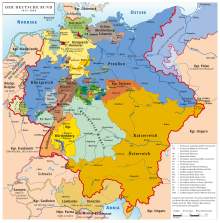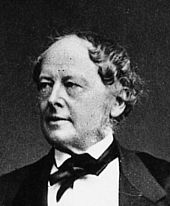Third Germany
A number of German states, especially during the time of the German Confederation (1815–1866), are referred to as Third Germany . Above all, this refers to larger and somewhat less large member states that, alongside the great powers Prussia and Austria, tried to pursue a common policy. The larger states, especially the kingdoms of Bavaria, Hanover, Saxony and Württemberg, were also called the medium- sized states .
A common policy mostly failed because of the contradictions between these states. Some were more inclined towards Austria, others more towards Prussia. Above all, they wanted to keep their independence. Hence they were suspicious of the largest of them, Bavaria. Prussia again tried, for example in the reform plan of 1866 , to take over leadership of the German Confederation together with Bavaria.
The question of a third Germany became superfluous in the course of the formation of the common federal state in 1866 / 67–1871. Prussia dominated the German Empire , while Austria had been pushed out of Germany.
backgrounds
The central reason for the emergence of the idea of a “third Germany” was the emergence of the Prussian-Austrian dualism in the 18th century. The focus was on the fears of the smaller imperial estates that they would become a mere disposal of the two great powers. However, attempts to work together failed primarily because of denominational differences, the resistance of the electors and the great imperial estates.
Of greater importance was the concept of Third Germany during the 19th century. A prerequisite for the emergence of a "third Germany" capable of acting at least theoretically alongside and, in case of doubt, against the two great powers Prussia and Austria was the emergence of efficient, medium-sized states. The gradual dissolution of the Holy Roman Empire of the German Nation between 1803 and 1806 contributed significantly to this. The Reichsdeputationshauptschluss of 1803 led to the secularization of the previous ecclesiastical imperial estates and to the mediatization of most of the smaller secular imperial estates. These territories passed into the possession of the larger countries, which were able to enlarge their area considerably. In the course of the formation of the Rhine Confederation , a number of smaller rulers and imperial knighthoods were mediated again. In direct connection with its founding, the Holy Roman Empire was dissolved and the remaining German states gained official sovereignty . The French-dominated Rhine Confederation became the organization of states outside Prussia and Austria during Napoleonic domination in Germany; of course, he was unable to develop an independent policy.
Especially after the end of the territorial changes within Germany at the Congress of Vienna , the ideas of the “Third Germany” began to play a significant role. Since then, the core of the third Germany has mainly included the now territorially and in some cases greatly enlarged medium-sized states of Baden , Bavaria and Württemberg . In Baden , the area of the state had quadrupled between 1802 and 1810, and in Württemberg it had doubled. The population also grew significantly. There was also the weakened Saxony . Particularly with regard to the constitutional states of Baden, Bavaria and Württemberg, there were also considerable differences in terms of the basic state structure compared to the major constitutional states of Austria and Prussia.
development
During the existence of the German Confederation there were several phases in which closer cooperation between these states in defense of their interests became apparent. During this time the name "Trias" came up for it. After the establishment of the German Confederation, Württemberg and Karl August von Wangenheim initially became the driving force. The triad idea experienced an initial boom after the Prussian Customs Act of 1818. The neighboring states in particular feared for their sovereignty due to pressure from Prussia to join the Prussian customs area. Bavaria, however, suggested a southern German customs union. In fact, a preliminary tariff agreement was signed between Bavaria, Baden, Württemberg, Hessen-Darmstadt and the Thuringian states . With the hope of a political counterbalance to Prussia and Austria, this development was supported by France . The project failed because of the fear that Bavaria would dominate and because of different economic and political interests. While the relatively highly developed Baden pleaded for free trade , Bavaria wanted to protect its economy through customs barriers. The plans were largely abandoned, only Bavaria and Württemberg merged to form a southern German customs union.
After the revolution of 1848/49 , the triad idea experienced another phase of increased attention. It was directed on the one hand against the small German union plans of Prussia and on the other hand against a simple reactivation of the German Confederation, as Austria demanded. The triad solution had supporters especially in Hanover , Bavaria and Württemberg. The programmatic impetus for this was provided by the Prime Minister of Saxony, Friedrich Ferdinand von Beust . In February 1850, the so-called four-king alliance of Bavaria, Saxony, Hanover and Württemberg was concluded. Although these states were in favor of revitalizing the German Confederation, they also called for radical reforms and a strengthening of the federal character. This included a federal government and a representative body at the federal level. At times, the Austrian Prime Minister Felix zu Schwarzenberg seemed to want to approve the plans , albeit for tactical reasons . There were supporters in Prussia too. It was only after violent disputes that Joseph von Radowitz was able to assert himself with his small German union plans. The medium-sized states subsequently put up considerable resistance; this contributed significantly to the failure of the Prussian hegemony plans. However, the various approaches blocked each other, so that in 1851 the German Confederation was merely restored.
However, there were still considerable supporters of a triad politics. In 1854, at the so-called Bamberg Conference, in view of the cooperation between Prussia and Austria in the Crimean War , the medium- sized states agreed to also coordinate their foreign policy. They also stuck to the moderately liberal reform plans for the German Confederation. A high point of these efforts was the Würzburg Conference of 1859. The driving force remained von Beust, and his Bavarian counterpart Ludwig von der Pfordten joined . Von Beust made a further attempt in this direction in 1861. All attempts in this direction always failed because of the resistance of Prussia and the disunity in Third Germany itself.
There were similar developments after the end of the Confederation, when the southern German states were no longer part of a higher-level confederation until the German Empire was founded . In the Peace of Prague, the southern German states had the express right to form a southern alliance (see, on the other hand, the North German Confederation ). However, like all previous approaches, this plan failed.
literature
- Wolfram Siemann: From confederation to nation state. Germany 1806–1871 . In: The new German history , Volume 7. Gutenberg Book Guild, Frankfurt am Main 1995, ISBN 3-7632-2997-3 .
- Jonas Flöter: Beust and the reform of the German Confederation. Saxon-Central State Coalition Policy in the Context of the German Question. Cologne / Weimar / Vienna 2001, ISBN 3-412-08901-X .
- Thomas Nipperdey : German History 1800–1866. Citizen world and strong state. Beck, Munich 1998, ISBN 3-406-44038-X .
- Jürgen Angelow : The German Confederation. Scientific Book Society, Darmstadt 2003, ISBN 3-534-15152-6 .

